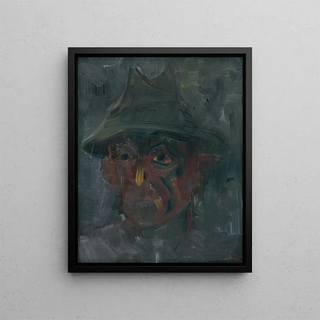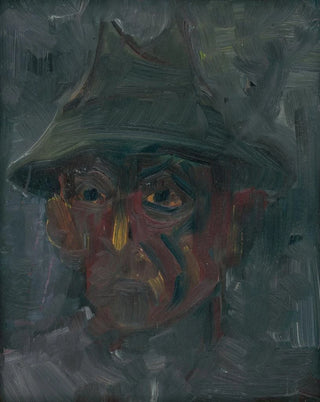Art print | Head of a man with a hat - Arnold Peter Weisz-Kubínčan Source: Reproduction | Tête d'homme au chapeau - Arnold Peter Weisz-Kubínčan


View from behind

Frame (optional)
Introduction captivating
The "Head of a Man with a Hat" by Arnold Peter Weisz-Kubínčan is a piece that inevitably draws the eye. This portrait, both mysterious and captivating, embodies an era where art blends with emotion, revealing a psychological depth that transcends mere visual appearance. In this work, the artist manages to capture not only the external look of his subject but also his essence, his character. The art print of this piece allows the viewer to immerse themselves in a universe where every detail matters, where each brushstroke tells a story.
Style and uniqueness of the work
Weisz-Kubínčan's style stands out for a blend of realism and expressiveness. In "Head of a Man with a Hat," the facial features are rendered with remarkable precision, while the choice of colors and shadows gives the portrait an almost lifelike dimension. The artist uses a subtle palette that evokes a range of emotions, oscillating between melancholy and contemplation. The hat, a central element of the composition, is not just a simple accessory; it becomes a symbol of the character's identity, a reflection of his social status and his era. This balance between realism and expressionism makes this work a perfect example of art's ability to evoke deep feelings while remaining grounded in reality.
The artist and his influence
Arnold Peter Weisz-Kubínčan, often recognized for his unparalleled talent, established himself as a major figure in the art world of the 20th century. Of Slovak origin, he was influenced by various artistic movements throughout his career, notably Surrealism and Expressionism. His ability to fuse these styles while maintaining a unique identity marked his work and allowed him to explore universal themes such as solitude, identity, and memory. The "Head of a Man with a Hat" perfectly illustrates this duality, where the artist manages to transcend cultural and temporal boundaries. His influence endures in the contemporary art world, inspiring many artists to explore the depths of the psyche.

Matte finish

View from behind

Frame (optional)
Introduction captivating
The "Head of a Man with a Hat" by Arnold Peter Weisz-Kubínčan is a piece that inevitably draws the eye. This portrait, both mysterious and captivating, embodies an era where art blends with emotion, revealing a psychological depth that transcends mere visual appearance. In this work, the artist manages to capture not only the external look of his subject but also his essence, his character. The art print of this piece allows the viewer to immerse themselves in a universe where every detail matters, where each brushstroke tells a story.
Style and uniqueness of the work
Weisz-Kubínčan's style stands out for a blend of realism and expressiveness. In "Head of a Man with a Hat," the facial features are rendered with remarkable precision, while the choice of colors and shadows gives the portrait an almost lifelike dimension. The artist uses a subtle palette that evokes a range of emotions, oscillating between melancholy and contemplation. The hat, a central element of the composition, is not just a simple accessory; it becomes a symbol of the character's identity, a reflection of his social status and his era. This balance between realism and expressionism makes this work a perfect example of art's ability to evoke deep feelings while remaining grounded in reality.
The artist and his influence
Arnold Peter Weisz-Kubínčan, often recognized for his unparalleled talent, established himself as a major figure in the art world of the 20th century. Of Slovak origin, he was influenced by various artistic movements throughout his career, notably Surrealism and Expressionism. His ability to fuse these styles while maintaining a unique identity marked his work and allowed him to explore universal themes such as solitude, identity, and memory. The "Head of a Man with a Hat" perfectly illustrates this duality, where the artist manages to transcend cultural and temporal boundaries. His influence endures in the contemporary art world, inspiring many artists to explore the depths of the psyche.






